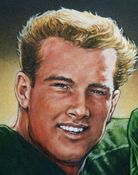 Paul Hornung was better than everyone else on a football field, according to Frank Leahy, his coach at Notre Dame, who said, “He could run through opposing teams like a mower going through grass.” Vince Lombardi, his coach with the Green Bay Packers, said, “Paul Hornung is the greatest player I’ve ever coached and the greatest I’ve ever seen on the football field within the 20-yard line.”
Paul Hornung was better than everyone else on a football field, according to Frank Leahy, his coach at Notre Dame, who said, “He could run through opposing teams like a mower going through grass.” Vince Lombardi, his coach with the Green Bay Packers, said, “Paul Hornung is the greatest player I’ve ever coached and the greatest I’ve ever seen on the football field within the 20-yard line.”
Hornung was born in 1935 and grew up in Louisville, Kentucky. His parents separated when he was two, and he was raised by his mother, who was a local state government worker. At his Catholic high school, he was the best football, basketball and baseball player and led his high school football team to the Kentucky state championship. He went to college at Notre Dame and was their best offensive and defensive football player, as their halfback and quarterback who ran, passed, punted, kicked field goals and extra points and returned kicks. He also led his team in scoring, tackles, interceptions, and kickoff and punt returns and won the Heisman Trophy as the country’s top college football player.
He went on to be the Green Bay Packers’ halfback, quarterback, fullback and place kicker, led the league in scoring three times and in 1961 was the NFL’s Most Valuable Player. In 1960, he held the record for points scored. In just 12 games, he scored 176 points on 15 touchdowns, 15 field goals and 41 extra points. He played on teams that won four NFL titles and a Super Bowl and was inducted into both the professional and college football halls of fame.
He was athletically gifted, with exceptional coordination to control the power that made him stronger and faster than other players. At age 22, at the 1957 College All Star game in Chicago, he raced and beat Abe Woodson by more than five yards in a specially matched 50-yard dash. Woodson was one of the fastest professional football players who had won national hurdle titles in college.
Off the field, Hornung was often seen smoking, drinking, and carousing with beautiful women. His professional football career was marred by injuries that eventually forced him to retire from football at age 31. He returned to Louisville, hosted a television sports show and bought and sold real estate. He also was a football analyst for CBS and Notre Dame. Later in life, he developed debilitating dementia and had to be placed in an assisted living home where he died of complications of dementia on November 13, 2020.
Hard Knocks of Football
Hornung broke his nose at least six times and had painful recurring nerve damage in his neck that eventually caused him to stop playing football in 1966. At age 81, in 2016, he filed a lawsuit against Riddell Manufacturing Company, charging that their helmets did not protect him from repetitive head trauma that caused him to become demented and suffer severe nerve damage.
Most people who suffer concussions recover and appear to be fine with no lasting effects. However, even one concussion on one occasion can cause permanent brain damage. A concussion is defined as temporary unconsciousness or confusion caused by a blow to the head, which happens frequently to athletes in contact sports. Symptoms of a concussion can include confusion, headache, double vision or blurry vision, dizziness, nausea or vomiting, memory loss, ringing in ears, difficulty concentrating, light sensitivity, loss of smell or taste, and trouble falling asleep.
I have written about some of the many great athletes whose later lives have been destroyed by the ravages of head trauma, including Gale Sayers, Nick Buonaconti, Mike Pyle, Muhammed Ali, Gordie Howe, Jerry Quarry and John Havlicek. An article in the Journal of the American Medical Association reported that 110 out of 111 autopsied brains of dead NFL players showed signs of Chronic Traumatic Encephalopathy, or CTE (JAMA, 2017;318(4):360-370). The study also showed that 177 of 202 deceased former football players, who died at the median age of 66 years, had brains that had signs of CTE. The more years of playing football, the greater the signs of brain damage.
Deaths From Dementia
Dementia causes almost 10 percent of deaths in North America today (National Vital Statistics Reports, March 14, 2019;68(2):1-2). Aging is a major risk factor for dementia, affecting 13 percent of North Americans over 65 and almost 50 percent of those over 85 (Alzheimer’s Assoc Facts and Figures, 2018). A study of more than 5000 people with an average age of 70 found that low muscle size is associated with increased risk for dementia (Age and Ageing, March 2017;469(2):250–257). Dementia eventually can cause a person to spend all his time in bed, which will cause extreme loss of muscle size and strength which is a strong predictor of death (Clinical Interventions in Aging, July 5, 2018;13).
Dementia Has Some Treatable Causes
Anyone who notices increasing forgetfulness, confusion or uncontrollable anger should get a medical evaluation for the cause as soon as possible. In addition to aging, known risk factors for dementia include:
• Family history of dementia
• History of head injuries
• Diabetes. A high rise in blood sugar after meals causes sugar to stick to and damage cells everywhere in your body including your brain, so risk for dementia is increased by all of the risk factors for diabetes such as excess fat in the liver and high insulin levels (Arteriosclerosis, Thrombosis and Vascular Biology, Mar 1, 1986;6:123–130).
• Heavy alcohol use (Neuropsychiatr Dis Treat, Jan 9, 2020;16:87–99)
• Smoking (Annals of Clin and Transl Neurol, Sept 5, 2018)
• Everything associated with damaged arteries, such as heart attacks, strokes, and clots and their risk factors: high blood pressure, high cholesterol, diabetes and so forth (JAMA Neurol, Oct 1, 2017;74(10):1246-1254).
• Inflammation (Annals of Neurol, July 23, 2002). An immune system that stays active all the time eventually can attack and destroy the brain. Infections, lack of exercise and a pro-inflammatory diet increase inflammation.
• Vitamin deficiencies. Lack of B12, folic acid, pyridoxine or vitamin D can damage nerves and brain cells (BMJ Case Reports CP, May 14, 2019;12:e229044).
• Thyroid disease (Neurobiol Aging, Apr 2009;30(4):600–606)
• Certain drugs taken long-term are associated with increased risk for dementia. These include drugs to treat thought disorders, Parkinson’s disease, depression, chronic obstructive lung disease, overactive bladder, allergies, gastrointestinal disorders, seizures and antidepressants (JAMA Intern Med, 2019;179(8):1084-1093).
For more information and detailed recommendations for a medical workup for memory loss, see Some Cases of Dementia Have Effective Treatments
Paul Hornung
Dec 23, 1935 – Nov 13, 2020


